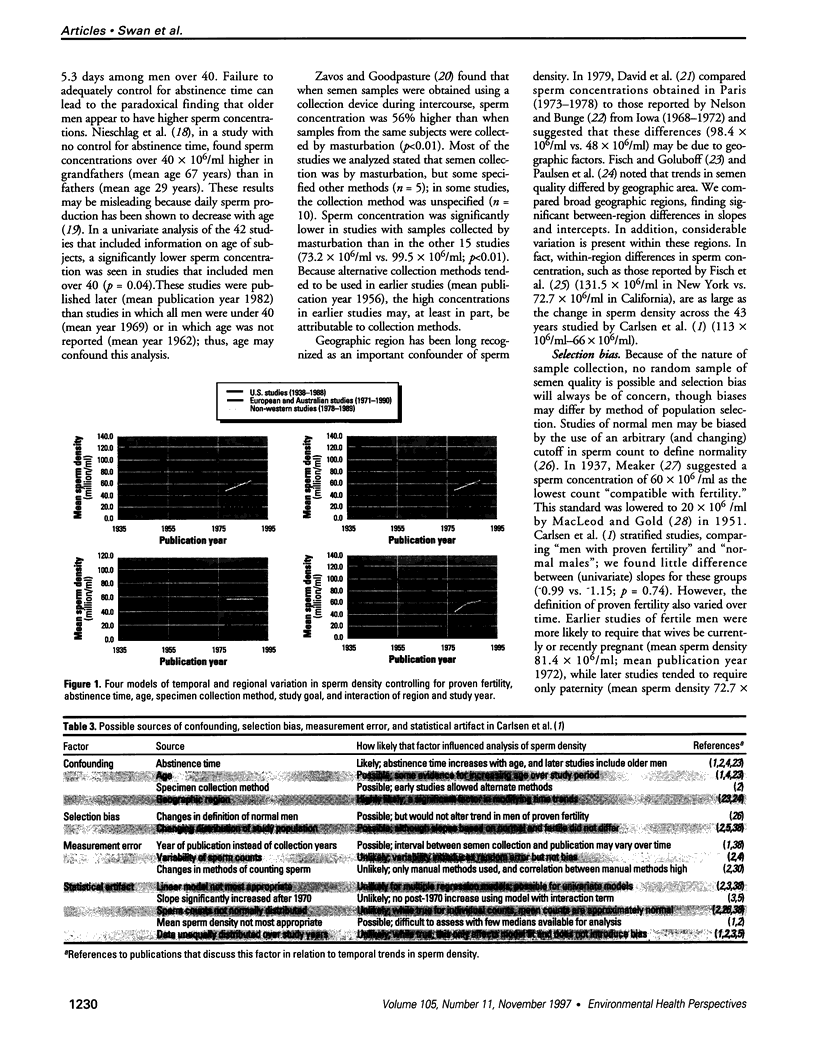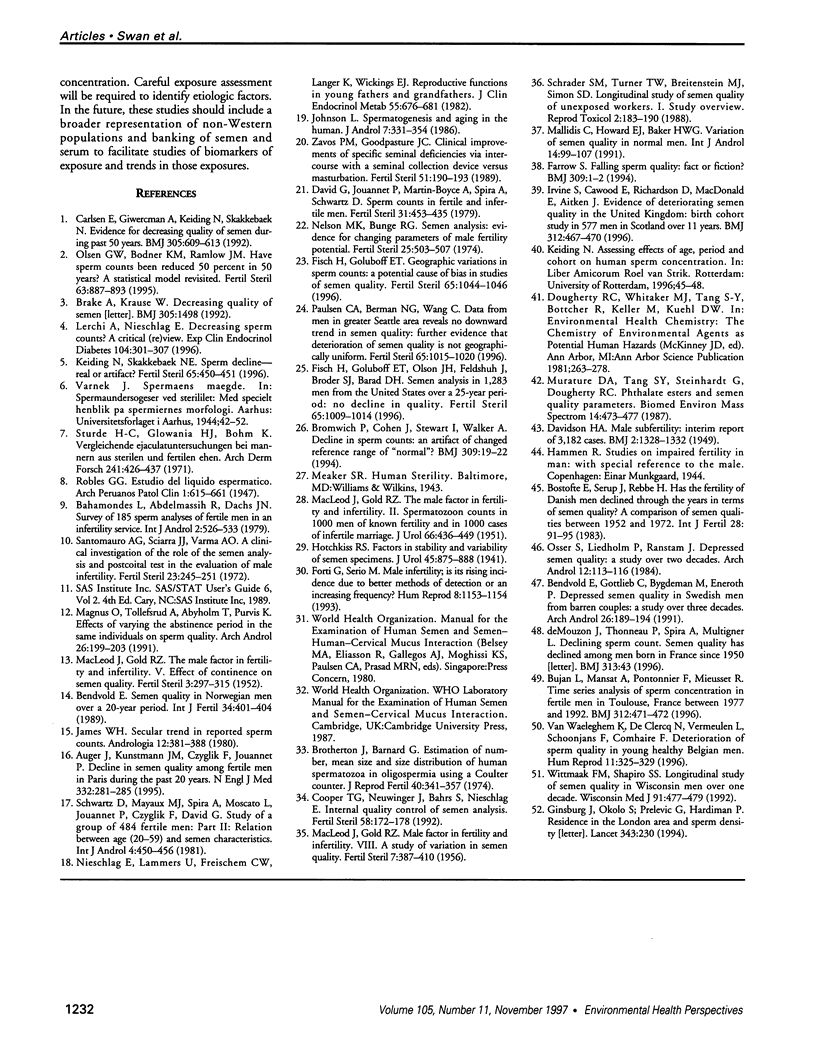Abstract
In 1992 a worldwide decline in sperm density was reported; this was quickly followed by numerous critiques and editorials. Because of the public health importance of this finding, a detailed reanalysis of data from 61 studies was warranted to resolve these issues. Multiple linear regression models (controlling for abstinence time, age, percent proven fertility, specimen collection method, study goal and location) were used to examine regional differences and the interaction between region (United States, Europe, and non-Western countries) and year. Nonlinear models and residual confounding were also examined in these data. Using a linear model (adjusted R2 = 0. 80), means and slopes differed significantly across regions (p = 0. 02). Mean sperm densities were highest in Europe and lowest in non-Western countries. A decline in sperm density was seen in the United States (studies from 1938-1988; slope = -1.50; 95% confidence interval (CI), -1.90--1.10) and Europe (1971-1990; slope = -3.13; CI, -4.96- -1.30), but not in non-Western countries (1978-1989; slope = 1.56; CI, -1.00-4.12). Results from nonlinear models (quadratic and spline) were similar. Thus, further analysis of these studies supports a significant decline in sperm density in the United States and Europe. Confounding and selection bias are unlikely to account for these results. However, some intraregional differences were as large as mean decline in sperm density between 1938 and 1990, and recent reports from Europe and the United States further support large interarea differences in sperm density. Identifying the cause(s) of these regional and temporal differences, whether environmental or other, is clearly warranted.
Full text
PDF




Images in this article
Selected References
These references are in PubMed. This may not be the complete list of references from this article.
- Auger J., Kunstmann J. M., Czyglik F., Jouannet P. Decline in semen quality among fertile men in Paris during the past 20 years. N Engl J Med. 1995 Feb 2;332(5):281–285. doi: 10.1056/NEJM199502023320501. [DOI] [PubMed] [Google Scholar]
- Bendvold E., Gottlieb C., Bygdeman M., Eneroth P. Depressed semen quality in Swedish men from barren couples: a study over three decades. Arch Androl. 1991 May-Jun;26(3):189–194. doi: 10.3109/01485019108987642. [DOI] [PubMed] [Google Scholar]
- Bendvold E. Semen quality in Norwegian men over a 20-year period. Int J Fertil. 1989 Nov-Dec;34(6):401–404. [PubMed] [Google Scholar]
- Bostofte E., Serup J., Rebbe H. Has the fertility of Danish men declined through the years in terms of semen quality? A comparison of semen qualities between 1952 and 1972. Int J Fertil. 1983;28(2):91–95. [PubMed] [Google Scholar]
- Brake A., Krause W. Decreasing quality of semen. BMJ. 1992 Dec 12;305(6867):1498–1498. doi: 10.1136/bmj.305.6867.1498-b. [DOI] [PMC free article] [PubMed] [Google Scholar]
- Bromwich P., Cohen J., Stewart I., Walker A. Decline in sperm counts: an artefact of changed reference range of "normal"? BMJ. 1994 Jul 2;309(6946):19–22. doi: 10.1136/bmj.309.6946.19. [DOI] [PMC free article] [PubMed] [Google Scholar]
- Brotherton J., Barnard G. Estimation of number, mean size and size distribution of human spermatozoa in oligospermia using a Coulter counter. J Reprod Fertil. 1974 Oct;40(2):341–357. doi: 10.1530/jrf.0.0400341. [DOI] [PubMed] [Google Scholar]
- Bujan L., Mansat A., Pontonnier F., Mieusset R. Time series analysis of sperm concentration in fertile men in Toulouse, France between 1977 and 1992. BMJ. 1996 Feb 24;312(7029):471–472. doi: 10.1136/bmj.312.7029.471. [DOI] [PMC free article] [PubMed] [Google Scholar]
- Carlsen E., Giwercman A., Keiding N., Skakkebaek N. E. Evidence for decreasing quality of semen during past 50 years. BMJ. 1992 Sep 12;305(6854):609–613. doi: 10.1136/bmj.305.6854.609. [DOI] [PMC free article] [PubMed] [Google Scholar]
- Cooper T. G., Neuwinger J., Bahrs S., Nieschlag E. Internal quality control of semen analysis. Fertil Steril. 1992 Jul;58(1):172–178. [PubMed] [Google Scholar]
- DAVIDSON H. A. Male subfertility; interim report of 3,182 cases. Br Med J. 1949 Dec 10;2(4640):1328–1332. doi: 10.1136/bmj.2.4640.1328. [DOI] [PMC free article] [PubMed] [Google Scholar]
- David G., Jouannet P., Martin-Boyce A., Spira A., Schwartz D. Sperm counts in fertile and infertile men. Fertil Steril. 1979 Apr;31(4):453–455. [PubMed] [Google Scholar]
- Farrow S. Falling sperm quality: fact or fiction? BMJ. 1994 Jul 2;309(6946):1–2. doi: 10.1136/bmj.309.6946.1. [DOI] [PMC free article] [PubMed] [Google Scholar]
- Fisch H., Goluboff E. T. Geographic variations in sperm counts: a potential cause of bias in studies of semen quality. Fertil Steril. 1996 May;65(5):1044–1046. doi: 10.1016/s0015-0282(16)58284-3. [DOI] [PubMed] [Google Scholar]
- Fisch H., Goluboff E. T., Olson J. H., Feldshuh J., Broder S. J., Barad D. H. Semen analyses in 1,283 men from the United States over a 25-year period: no decline in quality. Fertil Steril. 1996 May;65(5):1009–1014. doi: 10.1016/s0015-0282(16)58278-8. [DOI] [PubMed] [Google Scholar]
- Forti G., Serio M. Male infertility: is its rising incidence due to better methods of detection or an increasing frequency? Hum Reprod. 1993 Aug;8(8):1153–1154. doi: 10.1093/oxfordjournals.humrep.a138218. [DOI] [PubMed] [Google Scholar]
- GOLD R. Z., MACLEOD J. The male factor in fertility and infertility. VIII. A study of variation in semen quality. Fertil Steril. 1956 Sep-Oct;7(5):387–410. doi: 10.1016/s0015-0282(16)32460-8. [DOI] [PubMed] [Google Scholar]
- Ginsburg J., Okolo S., Prelevic G., Hardiman P. Residence in the London area and sperm density. Lancet. 1994 Jan 22;343(8891):230–230. doi: 10.1016/s0140-6736(94)91012-x. [DOI] [PubMed] [Google Scholar]
- Irvine S., Cawood E., Richardson D., MacDonald E., Aitken J. Evidence of deteriorating semen quality in the United Kingdom: birth cohort study in 577 men in Scotland over 11 years. BMJ. 1996 Feb 24;312(7029):467–471. doi: 10.1136/bmj.312.7029.467. [DOI] [PMC free article] [PubMed] [Google Scholar]
- James W. H. Secular trend in reported sperm counts. Andrologia. 1980 Jul-Aug;12(4):381–388. doi: 10.1111/j.1439-0272.1980.tb00650.x. [DOI] [PubMed] [Google Scholar]
- Johnson L. Spermatogenesis and aging in the human. J Androl. 1986 Nov-Dec;7(6):331–354. doi: 10.1002/j.1939-4640.1986.tb00943.x. [DOI] [PubMed] [Google Scholar]
- Keiding N., Skakkebaek N. E. Sperm decline--real or artifact? Fertil Steril. 1996 Feb;65(2):450–453. doi: 10.1016/s0015-0282(16)58118-7. [DOI] [PubMed] [Google Scholar]
- Lerchl A., Nieschlag E. Decreasing sperm counts? A critical (re)view. Exp Clin Endocrinol Diabetes. 1996;104(4):301–307. doi: 10.1055/s-0029-1211458. [DOI] [PubMed] [Google Scholar]
- MACLEOD J., GOLD R. Z. The male factor in fertility and infertility. II. Spermatozoon counts in 1000 men of known fertility and in 1000 cases of infertile marriage. J Urol. 1951 Sep;66(3):436–449. doi: 10.1016/S0022-5347(17)74358-3. [DOI] [PubMed] [Google Scholar]
- MACLEOD J., GOLD R. Z. The male factor in fertility and infertility. V. Effect of continence on semen quality. Fertil Steril. 1952 Jul-Aug;3(4):297–315. doi: 10.1016/s0015-0282(16)30962-1. [DOI] [PubMed] [Google Scholar]
- Magnus O., Tollefsrud A., Abyholm T., Purvis K. Effects of varying the abstinence period in the same individuals on sperm quality. Arch Androl. 1991 May-Jun;26(3):199–203. doi: 10.3109/01485019108987644. [DOI] [PubMed] [Google Scholar]
- Mallidis C., Howard E. J., Baker H. W. Variation of semen quality in normal men. Int J Androl. 1991 Apr;14(2):99–107. doi: 10.1111/j.1365-2605.1991.tb01071.x. [DOI] [PubMed] [Google Scholar]
- Murature D. A., Tang S. Y., Steinhardt G., Dougherty R. C. Phthalate esters and semen quality parameters. Biomed Environ Mass Spectrom. 1987 Aug;14(8):473–477. doi: 10.1002/bms.1200140815. [DOI] [PubMed] [Google Scholar]
- Nelson C. M., Bunge R. G. Semen analysis: evidence for changing parameters of male fertility potential. Fertil Steril. 1974 Jun;25(6):503–507. doi: 10.1016/s0015-0282(16)40454-1. [DOI] [PubMed] [Google Scholar]
- Nieschlag E., Lammers U., Freischem C. W., Langer K., Wickings E. J. Reproductive functions in young fathers and grandfathers. J Clin Endocrinol Metab. 1982 Oct;55(4):676–681. doi: 10.1210/jcem-55-4-676. [DOI] [PubMed] [Google Scholar]
- Olsen G. W., Bodner K. M., Ramlow J. M., Ross C. E., Lipshultz L. I. Have sperm counts been reduced 50 percent in 50 years? A statistical model revisited. Fertil Steril. 1995 Apr;63(4):887–893. doi: 10.1016/s0015-0282(16)57498-6. [DOI] [PubMed] [Google Scholar]
- Osser S., Liedholm P., Ranstam J. Depressed semen quality: a study over two decades. Arch Androl. 1984;12(1):113–116. doi: 10.3109/01485018409161159. [DOI] [PubMed] [Google Scholar]
- Paulsen C. A., Berman N. G., Wang C. Data from men in greater Seattle area reveals no downward trend in semen quality: further evidence that deterioration of semen quality is not geographically uniform. Fertil Steril. 1996 May;65(5):1015–1020. [PubMed] [Google Scholar]
- Santomauro A. G., Sciarra J. J., Varma A. O. A clinical investigation of the role of the semen analysis and postcoital test in the evaluation of male infertility. Fertil Steril. 1972 Apr;23(4):245–251. doi: 10.1016/s0015-0282(16)38881-1. [DOI] [PubMed] [Google Scholar]
- Schrader S. M., Turner T. W., Breitenstein M. J., Simon S. D. Longitudinal study of semen quality of unexposed workers. I. Study overview. Reprod Toxicol. 1988;2(3-4):183–190. doi: 10.1016/0890-6238(88)90020-2. [DOI] [PubMed] [Google Scholar]
- Schwartz D., Mayaux M. J., Spira A., Moscato M. L., Jouannet P., Czyglik F., David G. Study of a group of 484 fertile men. Part II: relation between age (20-59) and semen characteristics. Int J Androl. 1981 Aug;4(4):450–465. doi: 10.1111/j.1365-2605.1981.tb00729.x. [DOI] [PubMed] [Google Scholar]
- Sturde H. C., Glowania H. J., Böhm K. Vergleichende Ejaculatuntersuchungen bei Männern aus sterilen und fertilen Ehen. Arch Dermatol Forsch. 1971;241(4):426–437. [PubMed] [Google Scholar]
- Van Waeleghem K., De Clercq N., Vermeulen L., Schoonjans F., Comhaire F. Deterioration of sperm quality in young healthy Belgian men. Hum Reprod. 1996 Feb;11(2):325–329. doi: 10.1093/humrep/11.2.325. [DOI] [PubMed] [Google Scholar]
- Wittmaack F. M., Shapiro S. S. Longitudinal study of semen quality in Wisconsin men over one decade. Wis Med J. 1992 Aug;91(8):477–479. [PubMed] [Google Scholar]
- Zavos P. M., Goodpasture J. C. Clinical improvements of specific seminal deficiencies via intercourse with a seminal collection device versus masturbation. Fertil Steril. 1989 Jan;51(1):190–193. doi: 10.1016/s0015-0282(16)60455-7. [DOI] [PubMed] [Google Scholar]
- de Mouzon J., Thonneau P., Spira A., Multigner L. Declining sperm count. Semen quality has declined among men born in France since 1950. BMJ. 1996 Jul 6;313(7048):43–45. doi: 10.1136/bmj.313.7048.43. [DOI] [PMC free article] [PubMed] [Google Scholar]



